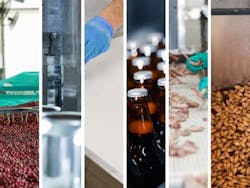Using innovative water treatment to meet food and beverage sustainability goals

Achieving sustainability while managing operational costs is a delicate balancing act for many industries. The food and beverage (F&B) sector faces unique challenges, such as high water consumption and product mix changes, which can complicate efforts to align costs with environmental goals.
This is why a water treatment partnership plays such an important role. By understanding a facility’s total water use and obstacles, companies can make positive changes to a water treatment program, including pre-treatment, utility, process and wastewater.
Kurita's F&B solutions, for example, are tailored to enhance production efficiency, ensure food safety and reduce environmental impact. This encompasses the full water cycle of F&B plants. At the same time, this approach provides results that prevent corrosion and scaling, removes effluent water contaminants and improves operational efficiency among other benefits.
Pre-treatment
Not every F&B facility requires pre-treatment before utility or process, but those facilities that need pre-treatment to improve water quality require a comprehensive solution. This starts with choosing the right chemistry, which is essential as a preventative measure to protect valuable assets and reduce a negative impact on environment. For facilities using reverse osmosis (RO) systems, proper chemical selection ensures these systems operate efficiently, reducing the risks of scaling, fouling and premature wear.
Kurita, for instance, specializes in membrane system protection with advanced treatments, which not only prolong the life of critical equipment but also minimize waste and optimize water consumption. (Discover how tailored a chemical program helped a beverage facility safeguard its operations with Avista Membrane Treatment Solutions.)
Utility water
Protecting a facility's assets ensures smooth operations and minimizes fuel consumption. By keeping utility assets clean from scale, corrosion and biofouling, carbon dioxide (CO2) emissions and water consumption are kept at a minimum.
For both boiler and cooling water utility treatments, Kurita’s innovative Cetamine technology can preserve assets while reducing chemical consumption. In the case of Cetamine in cooling water treatment, a proprietary combination of filming substances safely remove existing deposits and establishes a hydrophobic barrier. (Kurita helped a meat processing plant reduce their CO2 emissions by 180 tons annually using Kurita’s Cetamine in their system.)
Process water
From pasteurization and sterilization and everything else a process may include, Kurita provides an array of cleaning solutions — including liquid, foam-based and dry cleaners — tailored to specific applications. These programs are meticulously designed to protect both internal and external equipment and tools that come into contact with treated water, ensuring optimal performance and reliability.
For example, a distillery used Kurita’s ProClean when their evaporators were fouled. A very thick layer of calcium oxalate had added ten to twenty percent to their energy costs, increasing their clean-in-place (CIP) events too. Since using ProClean, the plant has seen five to ten percent improvement in cleanliness and efficiency.
Wastewater
Overtreating wastewater systems can lead to unnecessary chemical expenses and operational inefficiencies, which may result in costly surcharges or notices of violation (NOVs). Kurita offers an extensive range of wastewater treatment solutions from primary treatment to tertiary, including the Kurifloc and Kuribio product lines. These products are specifically designed to enhance contaminant removal and support biological augmentation during secondary treatment processes.
Looking to learn more? Check out Kurita's F&B guide.
About the Author
Daryl Mandoza
Product manager at Kurita America
Daryl Mandoza is a product manager for wastewater treatment solutions at Kurita America, specializing in liquid solid separation (LSS). He has a bachelor's and master's degree from Augsburg University and has worked in the water treatment industry for over 20 years.